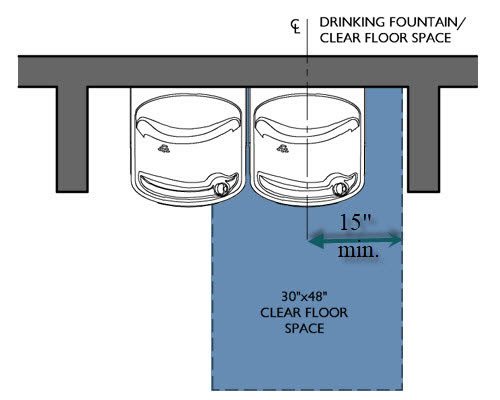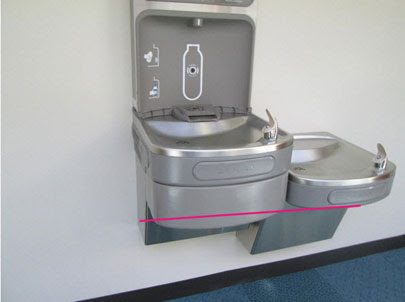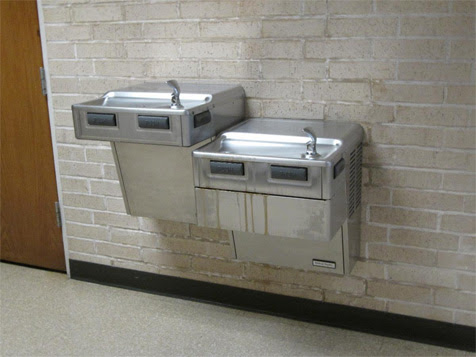August 2023: Cane detectable apron
Posted on - Wednesday, August 2nd, 2023Cane detectable apron
Lately I have been observing during my ADA/TAS inspections that most drinking fountains for standing people will have a cane detectable apron. A cane detectable apron is an item that is offered by the drinking fountain manufacturer in order to make their drinking fountains detectable for persons who are visually impaired. Since the person cannot see, they need to “feel” their way around. A person who uses a white cane to detect their environment will only be able to detect objects mounted at 27″ a.f.f. or below.

This ADA figure shows the extent of what is cane detectable
Keeping that in mind, if a drinking fountain is located in a circulation path where a person who is visually impaired would walk, it must either not project more than 4″ onto the path, or be mounted 27″ a.f.f. or lower so that they can “dectect” the object.
Since drinking fountain is required to have a knee and toe clearance for a forward approach so that a person in a wheelchair can use it, a minimum of 27″ a.f.f. below the drinking fountain will be required for the knee clearance, but it could be higher. Since it could be higher than 27″ a.f.f. it might be a possibility that it will not be cane detectable.
There is also a second requirement where an additional drinking fountain needs to be provided for standing persons. This requirement is for persons who have a disability where they cannot bend down and therefore the spout of the drinking fountain should be higher than that of a wheelchair. This drinking fountain does not require a knee and toe clearance, but most manufacturers have designed them to have one. When the drinking fountain is mounted so that a person who is standing can reach the spout, the bottom edge will be mounted higher than 27″ a.f.f.

When is the apron needed?
When the drinking fountain is located along the circulation path and the bottom edge is higher than 27″ a.f.f. a cane detectable apron can be used to provide cane detection. The apron is typically mounted below the high drinking fountain (for standing pesons) because those are the ones that most of the time have their leading edge higher than 27″ a.f.f.

WBeware that there is a requirement that the clear floor space for the wheelchair accessible drinking fountain must be centered. This means that if the low drinking fountain is adjacent the high drinking fountain, half of the 30″ clear floor space will be located under the drinking fountain for standin persons.
If a cane detectable apron will be required at the high drinking fountain, it cannot be located lower than 27″ a.f.f. since it will also reduce the knee clearance for the low drinking fountain located adjacent to it.
“

The cane detectable apron was lower than 27″ a.f.f. For standing persons this works since they don’t need a knee clearance, but for wheelchairs it does not work, because part of the knee space will be located below the apron
When is the apron NOT needed?
If the drinking fountains are already in an alcove, or a recess, then they will not need a cane detectable apron because the built in elements becomes the cane detection.

The cane detectable apron was not needed, sine they built walls to create an alcove where the drinking fountains would be mounted. These were not in a circulation path. In addition, they added the aprons to the low drinking fountain and reduced the knee space to less than 27″ a.f.f.

When there are misunderstanding
If I have seen many projects where cane detectable aprons are added when they are not needed.
- They are added at the drinking fountains for wheelchair users which then reduce the knee clearance
- They may be added when the drinking fountain is recessed
- They may be added lower than 27″ a.f.f. which reduces the knee clearance at the drinking fountain for wheelchair users adjacent.

The cane detectable apron was mounted at the wheelchair accessible drinking fountain which reduced the knee clearance
 Abadi
Abadi 
